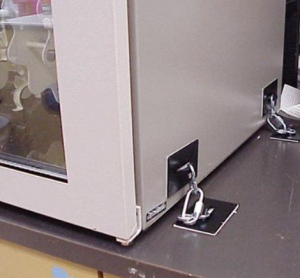Preparing Inside the Home
There is no guarantee that you’ll be home when the “big one” hits. But if your home has been prepared to withstand an earthquake or storm, you’ll find more there to appreciate when you DO get back.
I rode through the 1989 quake in the S.F. Bay Area in a restaurant. We came out shaken but unhurt. A couple of hours later I dropped off my colleague at her apartment. I went in with her. It was amazing.
The kitchen looked as though a whirling dervish had gone through every cabinet and cupboard and just tugged and thrown things out into the middle of the room. Broken glasses of relish and jam were mixed with dishes and pots and pans; fruit was mushed in with books and flour and, I remember, a broken bottle of vinegar. Broken flowerpots, broken fishbowl. (Who know where the fish was?) Plates and cups smashed, with a colander lying on top of them. Half the leftovers from the refrigerator, its door hanging open. Everything already starting to smell and spoil.
What a mess!

Step One — Take a Safety Inventory.
To start to prepare your house, simply do a walkthrough and take an inventory of WHAT WILL FALL OUT OR FALL OVER?
Step Two — Build Your Action List.
Now, systematically begin securing your home against this potential damage. Here are some ideas and some of the tools or equipment you’ll need.
* Rearrange storage. Put heavy things on lower shelves, precious things behind cabinet doors. Keep dangerous or toxic materials in low cabinets, too.
* Get latches for your cabinets. Easy, cheap to install.
* Use adhesive putty (“Museum putty”) to pin down collectibles or art work on shelves.
* Strap down computers, monitors and TV screens. (Over 300 people were killed from falling TVs last year, not even in earthquakes!) Strapping kits are available at home improvement stores.
* Fasten bookcases and wardrobes to the wall. Our recent purchase of bookcases at Ikea automatically included earthquake angle brackets.
* Keep books on the shelves, even if the bookcase doesn’t fall over. String a piece of fishing line across the shelf in front of the books, or use specially designed elastic cords.
* Wine bottles? Take a good look at your wine collection. Figure a way to restrain the bottles by enclosing them.
* Your refrigerator or dish washer may creep or fall in an earthquake. You can fasten it to the wall (to the studs) using plumber’s tape (metal straps with holes) or Velcro fasteners. Get some expert advice here before you attach anything to the refrigerator back.
If you’ve read this far, you realize that each house is different.
Action item: Do the walk-through today! If you have children, enlist their help. Start taking steps to make your home safer. (You’ll sleep better as a result, too.)
Virginia
Your Emergency Plan Guide Team
P.S. You’ll find some specific recommendations for safety fasteners, straps, etc. right here.
Don't miss a single Advisory.
Thank you for subscribing.
Something went wrong.
